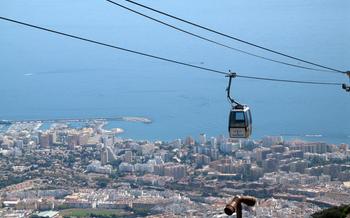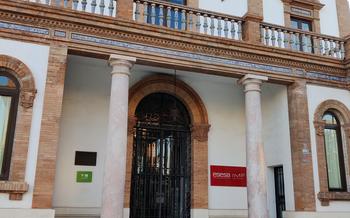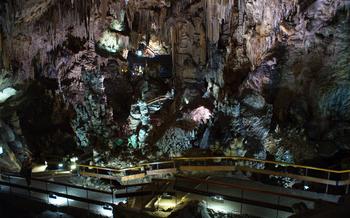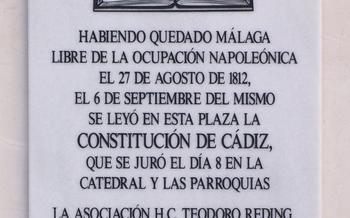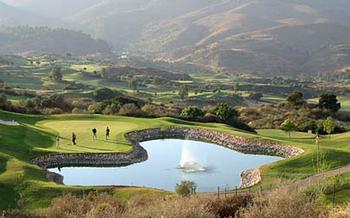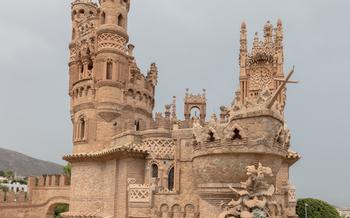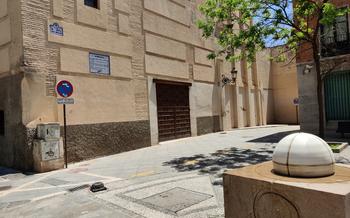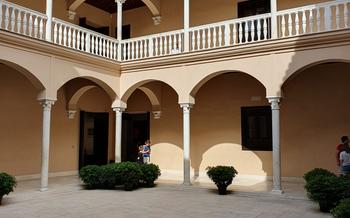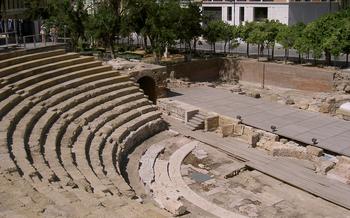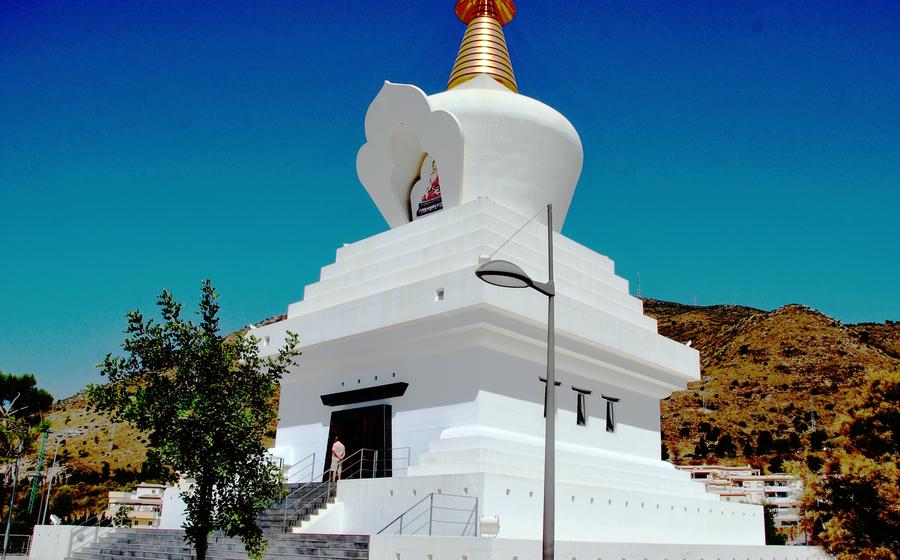
Buddhist Stupa of Benalmádena
- A Buddhist Stupa in Spain: An Overview
- Exploring the Stupa's Symbolism
- A Unique Architectural Masterpiece
- The Stupa's Place in Buddhism
- The Stupa's Surroundings
- Visiting the Stupa: Practical Information
- Finding Inner Peace at the Stupa
- The Stupa's Impact on Benalmádena
- Connecting with the Local Buddhist Community
- The Stupa's Unique Artwork and Artifacts
- Exploring the Stupa's Garden
- Local Legends and Folklore
- The Stupa's Contribution to Tourism
- Insider Tip: The Best Time to Visit
A Buddhist Stupa in Spain: An Overview
In the heart of Benalmádena, a coastal town in the southern Spanish province of Malaga, lies a unique architectural marvel: the Buddhist Stupa of Benalmádena. This magnificent structure, the largest Buddhist stupa in the Western world, stands as a testament to the rich cultural diversity and spiritual heritage of the region.
The construction of the stupa was initiated in 1973 under the guidance of the renowned Tibetan Buddhist teacher Lama Gyen Chok Rinpoche, who envisioned a center for peace and meditation in the heart of the Costa del Sol. The stupa was completed in 1992, marking a significant milestone in the history of Buddhism in Spain.
Architecturally, the stupa is a stunning blend of Buddhist and Spanish influences. Its whitewashed exterior, adorned with intricate Buddhist motifs and symbols, reflects the traditional architectural style of Buddhist stupas, while its location amidst the lush Mediterranean landscape echoes the Moorish heritage of the region.
The stupa holds immense religious and cultural significance, serving as a focal point for Buddhist practitioners and visitors from around the world. It is not only a place of worship but also a symbol of peace, harmony, and compassion, inviting individuals of all faiths to come together and explore the teachings of Buddha.
Address and Location Details:
The Buddhist Stupa of Benalmádena is located in the serene residential area of Benalmádena Pueblo, approximately 20 kilometers southwest of Malaga city. It is easily accessible by car or public transportation, making it a convenient destination for both local residents and tourists.
Exploring the Stupa's Symbolism
The Benalmádena stupa is a treasure trove of Buddhist symbolism, reflecting the rich tapestry of beliefs and teachings that form the foundation of this ancient religion. Every element of the stupa, from its shape to its intricate decorations, holds profound meaning.
At the base of the stupa, the Eightfold Path is represented by eight spokes radiating outwards. This path, a central tenet of Buddhism, guides individuals towards enlightenment through right understanding, right thought, right speech, right action, right livelihood, right effort, right mindfulness, and right concentration. Each spoke symbolizes one of these essential steps on the journey to spiritual liberation.
The stupa's dome represents the Buddha's mind, vast and expansive, containing all knowledge and wisdom. The pinnacle, or harmika, atop the dome symbolizes the Buddha's victory over ignorance and suffering. The umbrella-like structure above the harmika represents the Buddha's protection and compassion, sheltering all beings from harm.
The stupa's interior is adorned with beautiful murals and sculptures depicting the life and teachings of Buddha. These artworks serve as visual reminders of Buddha's journey from a prince to an enlightened being, his teachings on compassion, non-violence, and the path to Nirvana.
The stupa, with its rich symbolism and iconography, invites visitors to contemplate the profound teachings of Buddhism, encouraging them to reflect on their own spiritual journeys and to seek inner peace and liberation.
A Unique Architectural Masterpiece
The Buddhist Stupa of Benalmádena stands out as a unique architectural masterpiece, blending Buddhist and Spanish architectural elements in a harmonious fusion. The design of the stupa incorporates traditional Buddhist symbolism and iconography while reflecting the vibrant cultural heritage of Spain.
The stupa's distinctive features include its whitewashed exterior, intricate carvings, and colorful tiles that adorn its facade. The fusion of these elements creates a visually striking structure that seamlessly integrates into the surrounding Andalusian landscape.
The design of the stupa was inspired by various Buddhist stupas worldwide, particularly the Great Stupa of Sanchi in India. The stupa's shape is reminiscent of a dome, symbolizing the Buddha's mind and representing the universe. The four sides of the stupa feature entrances adorned with intricate carvings and sculptures, which depict scenes from Buddha's life and teachings.
The Benalmádena stupa is a testament to the skill and artistry of its creators, who harmoniously blended Buddhist and Spanish architectural styles. It is a unique and iconic landmark that contributes significantly to the architectural landscape of Malaga, attracting visitors from around the world who come to admire its beauty and spiritual significance.
The Stupa's Place in Buddhism
In the realm of Buddhism, stupas hold immense significance, serving as sacred monuments that embody the teachings and history of the religion. The Benalmádena stupa is no exception, showcasing the essence of Buddhist tradition and spirituality.
Stupas, in their traditional form, are typically associated with the preservation of relics or remains of important Buddhist figures or objects. The Benalmádena stupa, however, stands as a symbol of peace and harmony, embodying the essence of Buddha's teachings without enshrining any specific relics.
Drawing inspiration from the ancient stupas of India and Nepal, the Benalmádena stupa represents a fusion of Eastern and Western influences. It embodies the traditional stupa design, featuring a hemispherical dome symbolizing the sky and a square base representing the earth. The presence of a harmika, a square railing at the top of the dome, symbolizes the sacred realm and the Buddha's teachings.
The stupa's structure holds profound spiritual significance, echoing the path of enlightenment and the teachings of the Eightfold Path. Each of the eight sections of the stupa corresponds to one of the Eightfold Path's elements, guiding visitors on a journey of self-discovery and spiritual development.
Beyond its physical form, the Benalmádena stupa serves as a place of meditation and contemplation, inviting visitors to connect with their inner selves and find moments of tranquility amidst the serene surroundings.
The Stupa's Surroundings
The Buddhist Stupa of Benalmádena is nestled amidst a serene natural setting that enhances its spiritual aura. Visitors can explore the beautifully landscaped gardens that surround the stupa, offering breathtaking views of the surrounding mountains and the Mediterranean Sea. The inviting gardens are a sanctuary of tranquility, featuring a variety of Mediterranean flora and fauna. The paths that wind through the gardens encourage visitors to pause and appreciate the natural beauty that complements the spiritual significance of the stupa.
The stupa is a hub for the local Buddhist community, who find solace and inspiration within its sacred grounds. Visitors may have the opportunity to witness traditional Buddhist ceremonies or meditation sessions, which add to the overall spiritual ambiance. The stupa also hosts regular events and retreats, providing visitors with a chance to deepen their understanding of Buddhism and connect with fellow practitioners.
Visiting the Stupa: Practical Information
Visiting the Benalmádena Stupa:
-
Hours: The stupa is open to visitors daily from 9 am to 6 pm.
-
Admission: Entrance to the stupa is free and open to people of all faiths and backgrounds.
-
Dress Code: Visitors are expected to dress respectfully and maintain a peaceful demeanor while within the stupa's sacred grounds.
-
Guided Tours: Guided tours in various languages are available upon request, providing visitors with an in-depth understanding of the stupa's history, symbolism, and significance.
-
Educational Programs: The stupa's management offers educational programs, workshops, and classes for interested individuals, fostering a deeper connection with Buddhist teachings and practices.
-
Tips for Visitors: To fully appreciate the stupa's serene atmosphere, it is advisable to visit during the early morning or evening hours when the surroundings are less crowded and tranquil. Remember to bring comfortable shoes for walking around the gardens and a bottle of water to stay hydrated.
Finding Inner Peace at the Stupa
Amidst the tranquil ambiance of the Benalmádena stupa, visitors can find solace and embark on a journey of inner peace. The serene atmosphere, imbued with spiritual energy, invites practitioners to delve into meditation and connect with their inner selves. Whether seeking a moment of reflection or a profound spiritual experience, the stupa provides an ideal setting for contemplative practices.
As you step within the sacred space of the stupa, the gentle sound of chanting or the tinkling of wind chimes fills the air, creating a soothing soundscape that enhances the meditative state. The intricate iconography adorning the stupa's walls and niches becomes a source of inspiration and contemplation, guiding the mind towards deeper levels of awareness.
The stupa's architecture itself seems to mirror the path to enlightenment. Its dome-shaped structure represents the heavens, while the square base symbolizes the earthly realm. As visitors circumambulate the stupa, they are reminded of the cyclical nature of existence and the interconnectedness of all things.
Personal accounts of visitors and practitioners attest to the transformative power of the Benalmádena stupa. Many have found solace and tranquility within its sacred walls, experiencing a profound sense of connection to the divine. Whether through meditation, prayer, or simply sitting in silent contemplation, the stupa has become a sanctuary for spiritual seekers from around the world.
The Stupa's Impact on Benalmádena
The Buddhist Stupa of Benalmádena has had a significant impact on the cultural and social fabric of the city. As a symbol of peace and harmony, the stupa has played a vital role in promoting cultural diversity and understanding within the local community. The stupa has attracted visitors and pilgrims from around the world, fostering a sense of global connectivity and cultural exchange.
Moreover, the stupa has positively influenced Benalmádena's tourism industry. The city has seen an increase in tourist arrivals since the stupa's construction, as many visitors are drawn to the unique spiritual and cultural experience it offers. The stupa has also contributed to the city's reputation as a welcoming and tolerant destination, attracting individuals from various backgrounds and beliefs.
The integration of the stupa into the local community's traditions has further strengthened the bond between Buddhism and the people of Benalmádena. The stupa has become a symbol of tolerance and understanding, encouraging peaceful coexistence among people of different faiths and cultures. It has also served as a catalyst for interfaith dialogue and cooperation, fostering a sense of unity and respect within the diverse community.
Connecting with the Local Buddhist Community
The presence of the Buddhist stupa in Benalmádena has fostered a vibrant and welcoming Buddhist community. Visitors to the stupa have the unique opportunity to interact with Buddhist monks and lamas, who are always willing to share their knowledge, wisdom, and practices. The stupa serves as a hub for Buddhist teachings, workshops, and meditation sessions, offering visitors a chance to immerse themselves in the teachings of the Buddha and deepen their spiritual understanding.
Moreover, the Buddhist community in Benalmádena is committed to promoting cultural exchange and cross-cultural experiences. Visitors can participate in dialogues with monks and lamas, gaining insights into Buddhist philosophy, history, and traditions. These interactions foster mutual understanding and respect among people from different backgrounds, promoting interfaith dialogue and harmony.
The Stupa's Unique Artwork and Artifacts
Adorning the interior of the Benalmádena stupa is a captivating collection of artwork and artifacts that further enhance its spiritual and cultural significance. These artistic treasures, infused with Buddhist symbolism and iconography, invite visitors on a journey of exploration and discovery.
The stupa's walls are adorned with intricate murals depicting scenes from the life of Buddha and significant events in Buddhist history. Each mural narrates a tale, capturing the essence of Buddhist teachings and the profound impact of Buddha's message.
Among the most notable artworks is a magnificent statue of Buddha, radiating compassion and serenity. The statue, crafted with meticulous attention to detail, captures the essence of Buddha's teachings and serves as a focal point for meditation and contemplation.
In addition to the stunning murals and sculptures, the stupa houses a collection of religious artifacts, including prayer wheels, incense burners, and ceremonial objects. These artifacts provide a glimpse into the rituals and practices of Buddhism, offering visitors a deeper understanding of the faith's traditions and beliefs.
Exploring the stupa's artwork and artifacts is an immersive experience, allowing visitors to connect with the rich history, culture, and spirituality of Buddhism. These artistic treasures serve as a testament to the enduring legacy of the Buddhist faith and its profound influence on the world.
Exploring the Stupa's Garden
The Buddhist Stupa of Benalmádena is nestled amidst a beautifully landscaped garden that adds to its serenity and charm. As you stroll through the garden, you'll be greeted by a variety of flora and fauna that create a harmonious environment. The garden is designed to reflect the Buddhist philosophy of respect for nature and the interconnectedness of all living beings.
The lush greenery, colorful flowers, and aromatic plants create a tranquil atmosphere that invites visitors to relax and connect with the natural world. The garden also features a variety of trees, including pines, cypresses, and olive trees, which are all symbolic in Buddhism. These trees provide shade and offer a sense of peace and tranquility to the visitors.
Exploring the garden around the stupa is a delightful experience that allows visitors to appreciate the beauty of nature and its significance in Buddhist teachings. It's a place where one can find harmony between spirituality and the environment, and immerse themselves in the serene atmosphere created by the stupa and its surroundings.
Local Legends and Folklore
The Buddhist Stupa of Benalmádena is steeped in local legends and folklore, adding to its mystique and cultural significance. One popular legend tells the tale of a Buddhist monk who traveled from Tibet to Benalmádena in the 1970s. Guided by a vision, he chose this specific location for the construction of the stupa, believing it to be a place of great spiritual power.
Another legend speaks of the stupa's miraculous healing properties. It is said that a local woman suffering from a terminal illness was miraculously cured after visiting the stupa and praying for guidance. Since then, many people have flocked to the stupa, seeking solace, healing, and spiritual renewal.
These legends have become an integral part of the stupa's story, passed down through generations of locals and visitors. They reflect the deep cultural significance of the stupa, which has become a symbol of hope, healing, and spiritual transformation.
The Stupa's Contribution to Tourism
The Buddhist Stupa of Benalmádena has emerged as a major tourist attraction, drawing visitors from around the world. Its unique blend of Buddhist spirituality and Spanish architecture has captured the interest of culture enthusiasts, history buffs, and spiritual seekers alike. The stupa's presence has significantly contributed to the tourism industry in Benalmádena, generating revenue and creating employment opportunities for local residents.
Moreover, the stupa has played a pivotal role in promoting cultural tourism in the region. It has attracted tourists who are eager to explore the rich cultural heritage of Spain while experiencing the tranquility and spirituality of Buddhism. This cross-cultural exchange has fostered a deeper understanding and appreciation of different cultures and traditions among visitors.
The stupa's unique architectural features have made it a popular destination for photography and social media enthusiasts. Its stunning visuals and serene ambiance have captivated the imagination of travelers, who share their experiences and images online, further promoting the stupa and Benalmádena as a must-visit destination.
The stupa's contribution to tourism extends beyond its direct economic impact. It has helped to position Benalmádena as a diverse and welcoming destination, attracting tourists who value cultural experiences and spiritual exploration. This has enriched the city's tourism offerings and contributed to its reputation as a vibrant and cosmopolitan destination.
Insider Tip: The Best Time to Visit
For an optimal experience, plan your visit to the Buddhist Stupa of Benalmádena early in the morning, as the rising sun casts a warm glow on the stupa and its surroundings. This serene atmosphere is perfect for meditation and contemplation. Alternatively, if you prefer a more tranquil experience, visit the stupa during the late afternoon, when the crowds have dispersed and the setting sun creates a magical ambiance. Remember to bring a camera to capture the stunning views and the stupa's intricate details in the golden light.
